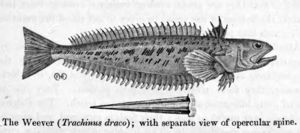Ordinary weever
| Ordinary weever | ||||||||||||
|---|---|---|---|---|---|---|---|---|---|---|---|---|

Ordinary weever ( Trachinus draco ), the second dorsal fin is not erected |
||||||||||||
| Systematics | ||||||||||||
|
||||||||||||
| Scientific name | ||||||||||||
| Trachinus draco | ||||||||||||
| Linnaeus , 1758 |
The Ordinary weever , even Great weever or simply weever ( Trachinus draco ) is a fish art from the family of weever (Trachinidae). It occurs in the coastal area of the eastern Atlantic , the North Sea and the entire Mediterranean Sea and lives on sandy soils.
description
The weever is on average 20 to 30 centimeters long, a maximum of 42 centimeters. The top is dark green, the underside light green. The flanks have a continuous light blue pattern. The lower jaw is longer than the upper jaw. The first, smaller dorsal fin with the large spiny rays is characteristic. These have deep longitudinal furrows in which the poison gland tissue is located. There is also a large, powerfully built venomous sting on the upper edge of the gill cover. The weever can be distinguished from the Viperqueise ( Trachinus vipera ) by its 2 or 3 small spines on the front upper edge of the eye socket.
Habitat and behavior
In summer the weever can be found at a depth of 5 to 15 meters. During the day it is usually buried in loose sand up to the eyes and thus lurks for prey. At night it also moves freely, often in small schools. In autumn it migrates to deeper zones.
Reproduction
The spawning season is from June to August. The eggs, about one millimeter in diameter, are released into the pelagic area .
food
The weever's diet consists of shrimps , gobies , lyrefish and the like.
Weever's sting
For example, when stepping on a weever in shallow water, poison may be injected through the poison sting. The toxin contained in the poison can cause severe pain, swelling, or paralysis. The toxin is thermally unstable and begins to decompose at around 40 °. It is recommended to warm up the pierced area as quickly as possible, for example by taking a foot bath or walking through hot sand. Exercise can help break down the poison in the victim's body. A medical examination is recommended.
literature
- BJ Muus: marine fish of the Baltic Sea, the North Sea, the Atlantic: biology, catch, economic. Meaning. 5th, through. Edition BLV Verlagsgesellschaft mbH, Munich 1985. ISBN 3-405-11861-1
Web links
- Greater Weever on Fishbase.org (English)
